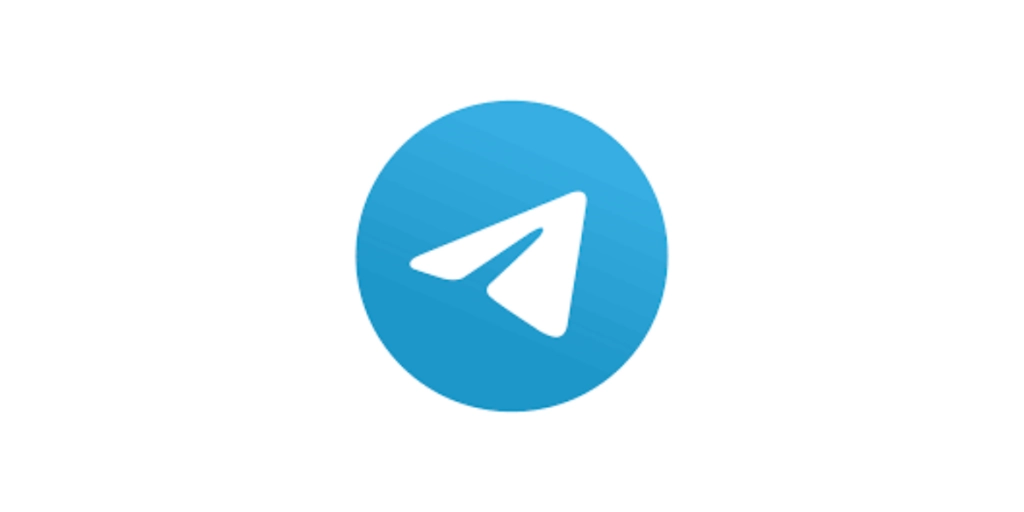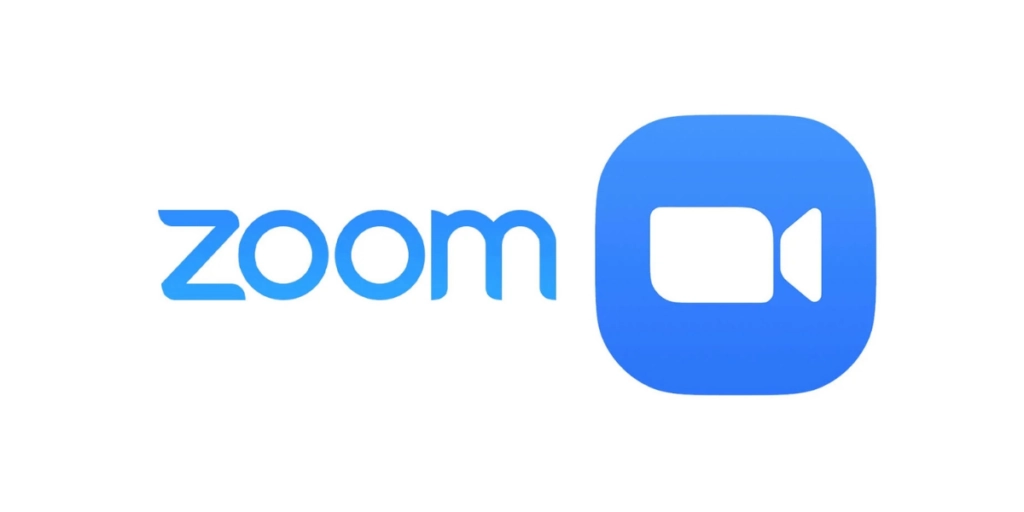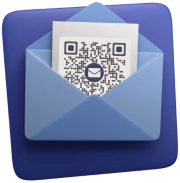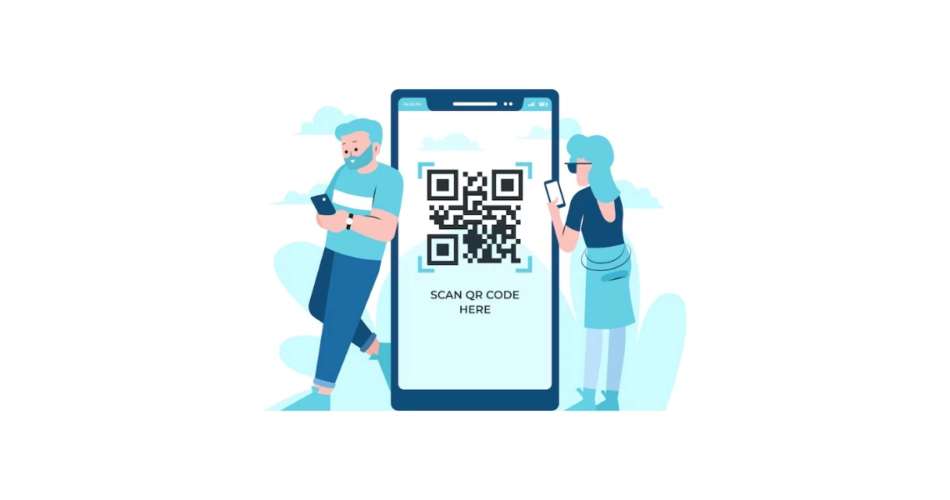With a simple scan, QRs can pay, access unique content, and quickly connect with your favorite apps.
That is how QR Codes work in mobile applications. These tiny squares have subtly grown to become among the most valuable tools in our digital age, facilitating the speed, ease, and interactivity of daily tasks.
Whether you’re getting coffee, opening a deal, or connecting to your preferred app, QR Codes make things easy and smooth for your users.
This article will explore why QR Codes are revolutionizing mobile applications. And how, in today’s mobile-centric society, they foster quick and intelligent interactions.
Now, let’s get started!
A typical smartphone user downloads and uses ten daily applications and 30 apps monthly. Source: radixweb
A. Real-life examples of QR Codes in mobile apps
1. WhatsApp QR Code
Let us find the answer to the question, what is a WhatsApp QR Code?
WhatsApp has an elegant trick up its sleeve for your use case.
To use WhatsApp on your desktop/laptop, you just need to scan the QR Code on the webpage. It will sync all your chats to the desktop without you typing in any credentials.
This benefits users with a seamless connection between devices for easy multitasking.
WhatsApp uses a traditional black-and-white QR Code for web login purposes. When you visit the website, a unique QR is displayed.
To log in, open WhatsApp on your phone, go to linked devices, and scan the QR Code with your phone’s camera. This will enable the chats to sync between your phone and browser.
You might be wondering how to get the WhatsApp QR Code. Simply visit web.whatsapp.com to get your QR Code.
Over 140 billion messages are sent via WhatsApp daily. To break it down, that’s 5833 million messages every hour, 97 million messages per minute, and 1.6 million messages each second. Source: doubletick
2. Snapchat QR Code
Snap’s QR Code allows users to easily add their friends without searching for usernames. You just need to point your camera at a Snapcode; voila, they’re instantly added to your friends list.
Snapcodes can even help unlock special filters and lenses, offering a fun way to interact with the app.
SnapChat’s QR Codes are customized QRs. They have a logo or an image in the center of a dotted pattern.
To get your Snapcode, you just need to tap on your profile icon from the Snapchat app. Then, select the Snapcode option and share your Snapcode with your contacts. It’s that easy!
If you are a business, you can generate custom snapcodes by visiting the Snapchat Ads Manager.
Snapchat has 406 million daily active users. Source: searchenginejournal
3. YouTube QR Code

YouTube offers an inbuilt QR code feature on smart TVs, allowing users to scan the code with their phone to log into their personal account on the TV.
This makes the login process much easier compared to the traditional method, which involves manually typing in a link and entering a code. By scanning the QR code, you can skip those steps and log in directly.
However, it doesn’t offer a direct feature for generating QR codes for YouTube channels, playlists, or specific videos. You can, though, use a URL QR Code generator to create a QR code for your YouTube content by simply entering the link.
4. WeChat Web QR Code
QR Code on the WeChat web login page has a function akin to WhatsApp, allowing users to log in by scanning a QR Code on the WeChat Web login page.
Since there is no need for a password, accessing your account is a safe method.
This function is well-liked in nations like China, where WeChat is extensively utilized for social and professional reasons.
The process of getting a QR Code is quite similar to WhatsApp. Just scan the QR Code by visiting WeChatWeb using your WeChat mobile app.
It uses a traditional black-and-white QR Code for both communication and payment purposes.
Users send over 45 billion messages and make over 410 million voice and video calls daily. Source: sinorbis
5. Telegram QR Code

Telegram is the only social media app that offers customization options for its QR code, allowing you to easily share your profile or invite people to join your Telegram group.
To create a personalized Telegram QR code, simply go to your profile panel, click on your profile icon, and tap on the QR code icon in the upper-right corner. From there, you can customize the color and download your unique QR code.
But that’s not all, Telegram also uses QR codes for logging into your account on a desktop using your mobile phone, just like WhatsApp. To do this, go to web.telegram.org/k/ and scan the QR code displayed on your screen with your mobile phone to log in.
6. Shopify QR Code generator
Shopify enables retailers to generate QR Codes for their goods, facilitating shoppers’ scanning and viewing of product details.
Marketing materials, actual storefronts, and social media posts can all include these QR Codes. Customers can access a product page or a special offer by scanning the code, which enhances the convenience and interactivity of purchasing.
To generate a Shopify QR Code, go to your account’s Shopify admin panel, select the product, and create a QR Code. The download is available in various formats, including jpeg and png.
These QR Codes are black and white and are mainly used by merchants to generate QRs for their products.
Unlike Shopify, Etsy sellers often use QR Code tools to promote their shops, since the platform lacks native support.
Upon scanning, the customers are taken directly to the product details page, where they can buy the product or redeem special offers.
There are over 4 million live e-commerce websites built and powered by Shopify. Source: webfx
7. WeChat QR Code
WeChat QR Codes have several uses. Social networking is made easier for users by allowing them to add friends instantaneously by scanning a code.
Users of WeChat Pay can also use QR Codes to make payments; they can display their code to scan or scan merchants’ codes.
This is now one of China’s most widely used payment methods, frequently replacing cash and credit cards.
How to get one: Any traditional QR Code can be scanned via the Snapchat camera. Users can generate or access Snapcodes through their profile, as explained earlier.
On average, users spend one hour and 20 minutes daily on WeChat. Source: sinorbis
8. Etsy sellers
To make it simpler for buyers to locate their shop or specific products, Etsy merchants can generate QR Codes.
Promotional materials, packaging, and business cards can all be printed with these codes. Scannable codes expedite purchasing by taking customers to a product page or the seller’s Etsy store.
How it works: Etsy sellers can create QR Codes that link directly to their shops or individual product listings.
By placing these QR Codes on packaging, promotional material, or business cards, sellers can provide a seamless shopping experience. This allows customers to scan and shop with ease.
How to get one: Etsy offers sellers the ability to generate QR Codes for free through their shop settings, and they can be shared digitally or printed for physical materials.
As of December 2023, Etsy was among the most popular online marketplaces in the United States, alongside others like Amazon and eBay.
9. LinkedIn QR Code
Each user’s LinkedIn profile has a unique QR Code that simplifies sharing your professional information at meetings or networking events.
Others may read your profile through the LinkedIn app and immediately connect with you by scanning the LinkedIn QR Code. It removes the need to look up someone’s profile or exchange business cards manually.
Each LinkedIn user has a unique QR Code linked to their professional profile. This code can be scanned at events or meetings, allowing others to access your profile quickly.
Also, they can send a connection request without manual searches or business card exchanges.
LinkedIn QR Codes are accessible directly within the LinkedIn app by tapping the search bar and selecting the QR Code icon.
More than 70% of LinkedIn users are from outside the United States. Source: LinkedIn
10. Zoom QR Code

This feature e Zoom QR codes serves two purposes. The first is the inbuilt QR code within the Zoom app, which is used for adding contacts. To access it, click on the “More” option in the bottom right corner, then select the QR icon next to your profile. You can share this QR code with others, allowing them to add you as a contact effortlessly.
If you want to create a QR code for a Zoom meeting, Zoom doesn’t offer a direct option. However, it’s still easy to generate one. Simply copy the meeting URL and paste it into Scanova’s URL QR Code generator. This simple process lets you create a QR code for a Zoom meeting.
11. Discord QR Code
Discord users can access their accounts on a computer by scanning a QR Code from the mobile app.
This feature ensures users don’t have to write in or remember their password, making logging in quicker and more secure.
For gamers and communities who constantly move between mobile and desktop platforms, it’s a well-liked choice.
Discord users can log in to the desktop app by scanning Discord QR Code from their mobile device. This removes the need to enter login credentials, offering a quicker, more secure method to switch between devices.
A QR Code will be displayed when logging in to Discord on a desktop. Open the Discord mobile app, go to the QR scanner in settings, and scan the code to log in instantly.
850 million messages get sent on Discord daily. Source: theshelf
12. Spotify codes
Spotify Codes, the platform’s take on QR Codes, are intended to make it simple for users to share and find new music.
Every song, album, artist, and playlist has the potential to have a distinct Spotify Code. Sharing music with friends is made simple by the code.
Spotify delivers the user immediately to the desired content—there is no need to email links.
It has a custom visual code format resembling a soundwave, known as Spotify Codes.
Each song, album, or playlist on Spotify can be shared via a unique Spotify Code. Scanning this code with the Spotify app takes the user directly to the media content, making it easy to share music without manually searching.
Spotify Codes can be generated within the Spotify app.
Select the media you want to share, tap the three dots, and the code will appear under the album art.
Others can scan it through the Spotify app’s search bar camera function.


13. Pinterest QR Code
Users of Pinterest can also generate QR Codes that point straight to their profiles, boards, or pins.
Bloggers, influencers, and companies who wish to distribute their Pinterest material in a simple, scannable format frequently use this tool. The codes can be shared on digital or printed products to drive visitors to particular Pinterest pages.
They just need to tap the share icon on their particular pin or post, and the option of sharing it as Pinterest QR Code will come up.
Global users spend an average of 1 hour and 45 minutes monthly on Pinterest’s Android app. Source: searchenginejournal
14. Apple Music QR Code
Apple Music subscribers can share QRs from the app to distribute their preferred tracks, playlists, or albums.
It opens instantly on the Apple Music app when the code is scanned, making it more straightforward for others to listen without doing a manual search.
Apple Music subscribers can share Apple Music QR Codes that link to songs, albums, or playlists.
When scanned, these codes open the shared content directly in the Apple Music app, allowing others to listen without searching. The QR Codes are black and white.
Apple Music allows users to generate QR Codes by using the sharing options within the app. These codes can be used across social platforms or in print.
Apple Music has generated $9.2 billion in revenue in 2023. Source: demandsage
15. TikTok QR Code
TikTok simplifies sharing profiles, assigning users a unique QR Code.
You can follow someone with just one click by scanning their QR Code, which sends you straight to their profile on TikTok.
It’s helpful for events and creators who want to expand their following swiftly.
TikTok assigns each user a personalized QR Code, which others can scan to access their profile and follow quickly.
This feature is frequently used at events and by creators to grow their audience without requiring manual profile searches.
Users can find and share their TikTok QR Code by navigating to their profile settings in the app, where the QR Code option is available for sharing.
B. Mobile apps with built-in QR Code scanner
1. Snapchat QR Code scanner
In addition to Snapcodes, conventional QR Codes can be scanned by Snapchat’s camera to direct users to websites, events, or particular content inside the app.
Because of this functionality, firms that want to increase traffic from offline to online marketing campaigns can use Snapchat as a flexible tool.
Did you know that SnapChat supports traditional QR Code scanning as well?
Snapchat’s QR Code scanner allows users to scan external QR Codes and link to specific websites, events, or content within the app.
This feature makes Snapchat a powerful tool for businesses looking to engage customers with unique online experiences through offline promotions.
2. Pinterest QR Code scanner
By scanning a code, users can instantly access particular boards, profiles, or pins on Pinterest thanks to its built-in QR Code scanner.
Businesses and brands frequently employ Pinterest QR Codes in their marketing campaigns to guide customers to carefully chosen product or collection pages. It’s a fantastic method of combining online and offline purchasing.
Pinterest QR Code scanner allows users to scan and generate QR Codes to access specific content like profiles, boards, or pins.
This feature is handy for brands and businesses linking offline marketing efforts to Pinterest pages, where customers can explore collections or purchase products.
To create QRs from Pinterest, you must go through the Pinterest app or website using the sharing options.
Pinterest is the world’s 15th most-used social platform in 2024, with over 522 million global active users. Source: searchenginejournal
C. The growing importance of QR Codes in mobile apps
The increased need for smooth, effective, and interactive user experiences is reflected in the significance of QR Codes in mobile apps.
QR Codes have become essential tools for bridging the digital and physical realms as consumer behavior and technology progress. The following are some salient features emphasizing their importance:
1. Enhanced user engagement
QR Codes facilitate quick interactions within mobile apps. Users can scan codes to access exclusive content, promotions, or features, creating a more engaging experience. This instant access drives higher user participation and satisfaction.
For example, Cadbury’s PlayPad app uses QR unlock stages to turn product packaging into a fun digital experience.
2. Contactless convenience
QR Codes offer a secure solution in a world where contactless payments and cleanliness are becoming increasingly important. They address health concerns while improving convenience by enabling users to make payments, check into events, or access services without touching a person physically.
3. Streamlined processes
QR Codes simplify processes such as app downloads, ticketing, and payments. Users can scan a code to be directed to app stores or specific app features, reducing friction and making interactions smoother.
4. Bridging offline and online experiences
QR Codes facilitate the interaction between the digital and physical realms. Using codes on products, advertisements, or packaging that customers can scan to get more information or promotions. This is one of the ways that businesses may enhance their marketing strategies.
5. Data collection and insights
Companies can use QR Codes to collect useful information about user behavior. Brands can customize their approaches and enhance user experiences by scanning a code. This will help them obtain insights into consumer behavior, preferences, and engagement levels.
6. Versatile marketing tool
Using QRs, brands can enhance their marketing efforts at a fair price. They can be used to promote mobile apps and raise brand awareness through social media campaigns, print ads, and product packaging.
7. Integration with loyalty programs
QRs are used by several companies to enhance their loyalty programs. Customers can scan codes using the smartphone app to earn points and redeem rewards. This increases brand connections and encourages repeat business.
8. Increased security and authentication
In particular, mobile apps that use QRs for authentication can benefit from increased security.
By enabling users to scan codes for safe login, they can be utilized in two-factor authentication procedures. This lowers the possibility of unwanted access.
9. Augmented reality experiences
Mobile apps are increasingly using QR Codes to enable augmented reality experiences. Scanning codes enable users to access interactive features or material that boost engagement and offer distinctive experiences.
10. Real-time feedback and surveys
QR Codes facilitate immediate feedback collection. Businesses can use them to direct users to surveys or review platforms, helping gather insights on products or services and improving customer satisfaction.
D. Benefits of integrating QR Code in apps
Here are the benefits of integrating QR Codes in mobile apps, with more descriptive details:
1. Easy user interactions
QR Codes allow users to scan to reach specific content or features in the app without any hassle. This makes navigation straightforward and user-friendly.
2. Higher conversion rates
Users can go straight to product pages or checkout procedures by scanning QR Codes. As a result, fewer steps are required to make a purchase, potentially increasing sales.
3. Better marketing campaigns
Companies can design distinctive QR Codes for every marketing initiative. By tracking how frequently each code is scanned, they can quickly determine which initiatives are successful.
4. Instant promotions
Brands can create QR Codes that allow instant access to exclusive deals or transient promotions. This pushes people to take action, increasing sales when a product is on sale.
5. Easy app downloads
Users can access app download sites directly from app stores by scanning QR Codes. Users won’t have to search anymore, which makes installing apps much easier.
6. Cross-promotion
Companies can advertise their websites, other apps, and social media profiles by using QR Codes. This improves brand visibility overall and generates traffic across various channels.
7. Better inventory management
Retail apps can implement QR Codes to help staff check stock levels swiftly. Employees can easily manage inventory by scanning items, ensuring products are always in stock.
8. Engagement at events
QR Codes can facilitate quick sharing of contact information or social media profiles at events. This makes networking easier and helps attendees connect without hassle.
9. Easier user onboarding
New users can scan QR Codes to access quick-start guides or tutorials within the app. This helps them learn how to navigate and use the app effectively.
E. Types of QR uses in mobile apps
QR Codes have versatile applications in mobile apps across various industries. Here are some common types of uses for QR Codes in mobile apps:
1. Payment and transactions
Users can make quick and simple payments directly from their mobile wallets by scanning QR Codes. This capability makes smooth peer-to-peer payments via apps like PayPal and Venmo possible.
2. Marketing and promotions
Brands can create QR Codes that grant access to exclusive deals or discounts. Through the app, users can redeem promos by scanning these codes.
Also, users can obtain comprehensive product descriptions, reviews, and pricing details by scanning a QR Code.
3. Event ticketing
Apps like Eventbrite use QR Codes for electronic tickets. Attendees can scan their codes at entry points, allowing quick and efficient access to events.
If you want to create tickets for your event, you can always go for Ticket Generator
4. Social media engagement
Apps like Snapchat and Instagram allow users to share their profiles using QR Codes. Scanning a code lets users follow accounts or connect easily.
5. Customer feedback and surveys
Businesses can use QR Codes to direct users to feedback forms or surveys. This allows for a quick collection of customer insights and helps improve services.
6. Product authentication
By attaching QR Codes to their products, businesses may help customers verify the integrity of their offerings. Because consumers may scan the code to confirm that the goods are legitimate, counterfeiting is reduced.
7. Loyalty programs
Customers can scan codes at the register to receive prizes or accrue points using retail apps that use QRs for loyalty programs.
8. Inventory management
Retail and warehouse management systems can use QR Codes for quick inventory checks. Employees can scan codes to update stock levels or locate items.
The global mobile app market was valued at $469 billion in 2022 and is projected to reach $613 billion by 2025.
What our customers say about us:
F. Future trends for QR Codes in mobile app development
QR Codes have become a vital tool in mobile apps, helping users interact faster and easier.
As technology moves forward, QR Codes will continue to be necessary. Here are some trends we can expect for QR Codes in mobile app development:
1. Better security
More apps will use encrypted QR Codes to keep user data safe. These codes will protect people from hacking and phishing.
When choosing a QR Code generator, security should come first for both developers and business owners.
QR Codes connect users to digital content and may carry sensitive details like personal info or business data. With growing threats, picking a generator that meets top security standards is vital.
ISO Certification: Global Standards for Safety
ISO certifications show that a service follows strict rules for quality and safety. For QR Code generators, ISO 27001:2022 focuses on keeping data safe. A generator with this certification ensures your data is protected through strong security measures like risk checks and access controls.
SOC 2 Compliance: Protecting Cloud Data
SOC 2 compliance is key for businesses using cloud-based services. This certification looks at how well a company protects and manages data. It focuses on:
1. Security: Safeguarding systems from unauthorized access.
2. Availability: Ensuring the service works when needed.
3. Processing Integrity: Making sure codes are accurate and safe.
4. Confidentiality: Keeping sensitive information secure.
5. Privacy: Protecting personal data according to strict rules.
SOC 2 compliance means the QR Code generator has strong data security controls, keeping your business and users safe.
GDPR Compliance: Protecting User Privacy
The General Data Protection Regulation (GDPR) sets strict rules for handling personal data in the EU. Even if your business isn’t based in Europe, you must follow these rules if you deal with EU users.
A GDPR-compliant QR Code generator:
– Gets user consent before collecting or using data.
– Limits the data collected, only encoding what’s necessary.
– Encrypts data to prevent unauthorized access.
– Respect user rights, allowing them to access, change, or delete their data.
Not following GDPR can lead to heavy fines. For businesses working with EU customers, using a generator that follows these rules helps avoid legal trouble and keeps customer trust.
Why Security Matters
Using a secure QR Code generator protects more than just data. It protects your business’s reputation. A weak QR Code could lead to scams or data theft, costing customers and trust. Developers also need tools that are not only functional but secure.
Choosing a generator that meets ISO, SOC 2, and GDPR standards ensures your business and customers are safe from threats like hacking or fraud. These certifications show a commitment to security, keeping your data protected and your business running smoothly.
1. Augmented reality (AR)
You may access engaging AR experiences in apps by using QR Codes. For instance, seeing product demos or 3D models may be accessed by scanning a QR Code.
Before purchasing, you can virtually try items out using augmented reality by scanning their QR Codes.
2. More contactless services
QR Codes will be used more for payments. You can scan and pay without touching anything, especially in stores and restaurants.
Hotels, restaurants, and other places will use QR Codes to offer touchless check-ins or ordering.
3. AI and Smart QR Codes
AI will help create QR Codes that offer personalized experiences. For example, scanning a code could recommend products based on your past behavior.
It will also make scanning easier. If a QR Code is damaged, AI can still read it.
4. Blockchain for QR Codes
Blockchain technology will enable the development of safe QR Codes that authenticate products. Scan the code to learn more about the product’s origins and manufacturing process.
For example, blockchain-backed QR Codes can be used in banking and government services to verify digital identities.
5. Connected Devices (IoT)
You can use QR Codes to link your phone to smart devices in your house. For instance, a smart thermostat may be rapidly configured by scanning its code.
Packages with QR Codes will give real-time status updates on items in transportation or healthcare.
6. Combining NFC with QR Codes
Some apps will combine NFC (near-field communication) with QR Codes. This will give users more options for paying or interacting with services by either scanning or tapping.
7. Personalized marketing
Businesses will send customized offers and promotions using QR Codes. Users will see personalized content when they scan a code.
Depending on your current location, QR Codes can send you real-time offers. For instance, a store’s code scanner may display bargains that are close by.
8. Cross-platform use
QR Codes will eventually function on all platforms and gadgets. You can scan the same QR Code with any phone or app.
The average 30-day retention rate for apps is around 6%, meaning most users stop using an app within a month of downloading.
G. Best practices for designing and using QR Codes in apps
QR Codes can improve the user experience in mobile apps through faster and simpler interactions.
Observing best practices is crucial to get the most out of them. To create and use QR Codes in apps, remember these important pointers:
1. Keep the design simple
Use high contrast between the QR Code and the background. Avoid clutter so that it’s easy to scan.
Make sure the code is big enough to scan. A good size is at least 2 cm x 2 cm. Also, test the code on different phones and under different lighting.
2. Use Dynamic QR Codes
Dynamic codes let you change the content behind the code without creating a new one. These codes let you track how many people scan them and where they are.
3. Add clear instructions
Add a label like “Scan to Download” to show users what happens when they scan. Also, put the QR Code in an easy-to-reach place within your app.
4. Focus on security
Make sure the QR Code leads to a trusted website or secure location. For apps with sensitive data, use encrypted QR Codes to protect user info.
5. Make content mobile-friendly
If the QR Code leads to a webpage, ensure the site works well on mobile. Ensure that content or features are accessed by scanning load.
6. Customize with your brand
Include your logo or brand colors in the code design, but keep it easy to scan. Use QR Codes in creative spots like app onboarding or promotional material.
7. Test in real conditions
Test the code in different environments, like low light or outdoors. Make sure the code works when scanned from different distances and angles.
8. Keep data small
Use a short URL in the QR Code to make scanning easier. Keep the code simple. Link to more info rather than crowding the code with data.
9. Link QR Codes to app features
Ensure users can easily get to what they need after scanning the code. Use QR Codes to unlock rewards or offers, encouraging users to engage more.
A seamless experience often depends on smart implementation, which can be achieved through quality mobile app development services that align QR interactions with the app’s core functionality.
Brands that trust us:
Summing Up
QR Codes, a straightforward but effective technique, can improve mobile app experiences.
Adding QR Codes to your app is a wise decision that keeps you ahead of the curve, whether your goals are to increase security, provide contactless services, or customize user journeys.
Use QR Codes in your app right now to give it more life and user-friendliness!


